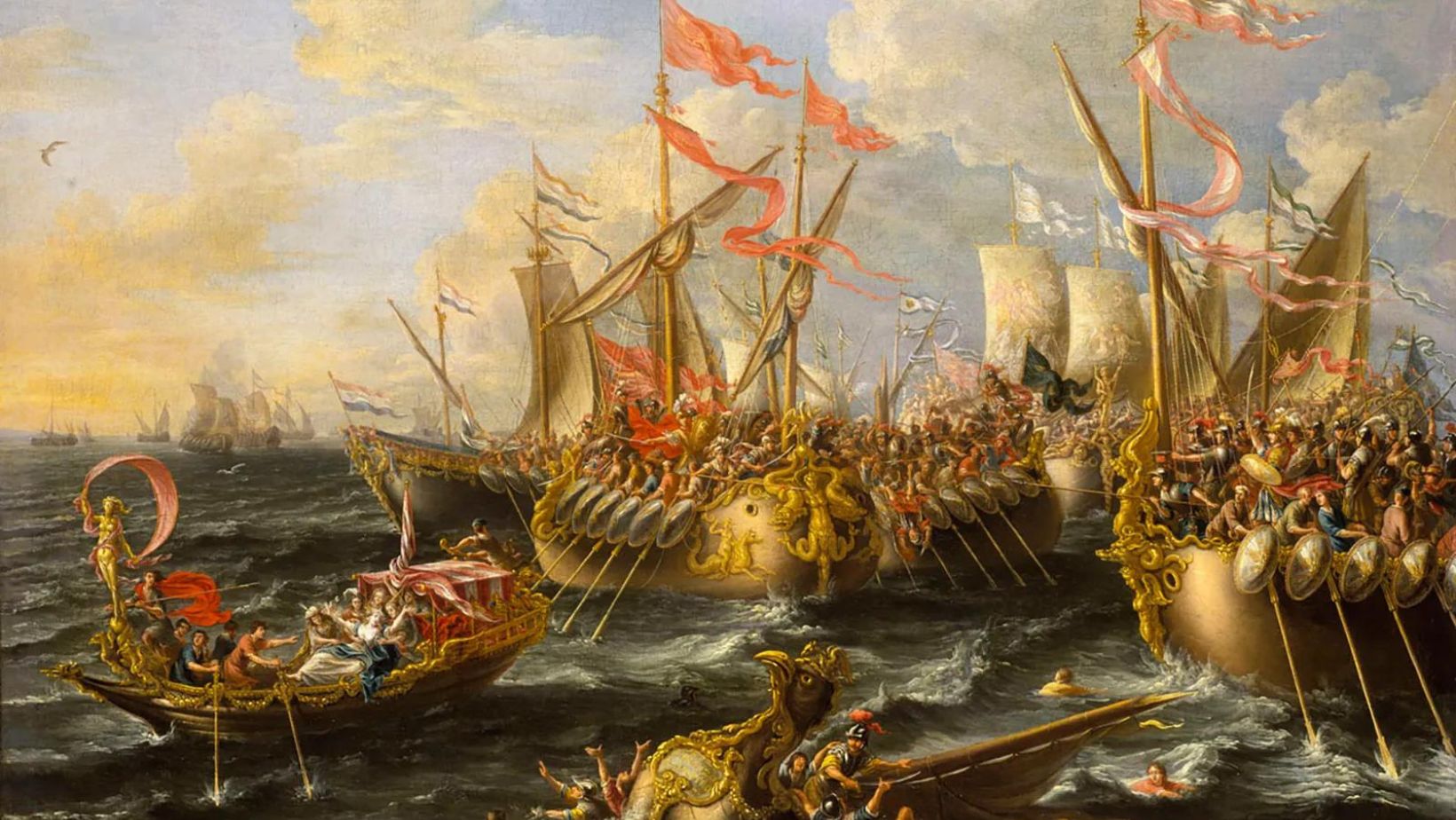Ever wondered how Cleopatra’s navy held its ground against the colossal powers of Rome? This isn’t just about ships sailing across the Mediterranean; it’s a tale of cunning strategy, fierce loyalty, and an unmatched determination to protect Egypt at all costs. From wooden warships to strategic battles that would make or break empires, we’re stepping back in time to uncover how this formidable fleet became a pivotal force in ancient history.
Table of Contents:
- The Battle of Actium: Cleopatra and Antony’s Naval Defeat
- Antony and Cleopatra’s Fateful Strategy
- The Might of Octavian’s Fleet
- The Downfall of Antony and Cleopatra
- Conclusion
The Battle of Actium: Cleopatra and Antony’s Naval Defeat

The Battle of Actium was a defining moment in naval history. It marked the end of the Roman Republic and the rise of the Roman Empire.
The clash between Mark Antony and Octavian was the culmination of years of civil war that followed the assassination of Julius Caesar. The once-allies turned bitter rivals, with the fate of Rome hanging in the balance.
Prelude to the Battle: Cleopatra’s Navy
In 32 BC, Octavian convinced the Roman Senate to declare war on the Egyptian queen Cleopatra. Antony, Cleopatra’s lover and ally, divorced his wife, Octavia Minor, Octavian’s sister. Antony and Cleopatra combined their forces to fight Octavian in a naval battle near the city of Actium.
The Clash of Fleets
The Battle of Actium took place on September 2, 31 BC. Antony had 500 ships, which were large but less maneuverable. Octavian had 400 smaller, swifter ships under the command of Marcus Vipsanius Agrippa. As the battle raged, Cleopatra’s ships suddenly retreated, breaking through the lines. Antony followed her with a few ships, abandoning his fleet.
During the encounter, Cleopatra’s fleet, which had taken position in the rear, sailed into the open sea headed for Alexandria.
Aftermath and Consequences
Octavian’s forces defeated Antony’s fleet. Many of Antony’s men deserted him after the battle. The defeat marked the end of Antony and Cleopatra’s military power. Octavian pursued them to Egypt. Trapped and with no way out, Antony committed suicide by falling on his sword. Cleopatra also committed suicide, allegedly by allowing an asp (Egyptian cobra) to bite her.
Octavian’s victory at Actium made him the undisputed master of the Roman world and marked the end of the Roman Republic and the beginning of the Roman Empire.
Antony and Cleopatra’s Fateful Strategy: Cleopatra’s Navy
The events leading up to the Battle of Actium were a complex web of political intrigue, personal ambitions, and strategic miscalculations. At the heart of it all was the tumultuous relationship between Mark Antony and Cleopatra.
Antony’s Divorce and Departure
In 32 BC, Antony divorced Octavia, Octavian’s sister, publicly humiliating Octavian. The outraged Roman Senate stripped Antony of all his official power and declared war on Cleopatra. Antony left Octavia in Rome and departed to reunite with Cleopatra in Egypt to prepare for battle against Octavian.
Cleopatra’s Influence: Cleopatra’s Navy
Cleopatra urged Antony to fight Octavian at sea, where the Egyptian fleet could play a role. Antony moved his fleet to the Ambracian Gulf near Actium, where Cleopatra provided 60 ships to supplement his own.
Cleopatra knew Antony would be outnumbered on land, so she convinced him to fight at sea. However, this decision would prove to be a fatal mistake.
Preparing for Battle
Antony had a larger fleet than Octavian, but many of his ships were undermanned. Antony threw wooden towers on his ships to make them into floating fortresses. He planned to use them as platforms to board enemy vessels.
However, this made his ships slower and harder to maneuver than Octavian’s smaller, swifter ships.
As the two fleets gathered in the Ambracian Gulf, tensions were high.
Key Takeaway: Cleopatra’s Navy
The Battle of Actium was a turning point, ending the Roman Republic and starting the Empire. Antony and Cleopatra’s defeat came down to their risky naval strategy against Octavian’s swift fleet. This clash marked their downfall, shifting power to Octavian.
The Might of Octavian’s Fleet: Cleopatra’s Navy
Octavian’s fleet was a force to be reckoned with. He had the advantage of smaller, swifter ships that were ideal weapon platforms.
These vessels could outmaneuver Antony’s larger, slower ships and attack from the sides with catapults, ballistas, and archers.
Octavian’s Naval Advantage
Octavian had about 400 ships, mostly smaller liburnian vessels, which were more maneuverable than Antony’s heavy warships.
Unencumbered by wooden towers, Octavian’s ships were built for speed and agility. They could run circles around Antony’s fleet and strike with precision.
Agrippa’s Strategic Command: Cleopatra’s Navy
Octavian’s fleet was commanded by his loyal friend Marcus Vipsanius Agrippa, an experienced admiral.
Agrippa’s strategy was to stay on the defensive and let Antony make the first move. He kept his ships in tight formation to neutralize Antony’s superior numbers.
When Antony finally attacked, Agrippa countered by using his smaller ships’ superior speed and maneuverability to flank Antony’s ships. It was a brilliant tactical move.
Targeting Antony’s Weaknesses
Octavian knew Antony’s ships were undermanned and that Antony had lost the support of many legions. Morale was low.
Octavian’s plan was to blockade Antony at Actium, cutting off his supply lines while avoiding direct confrontation with Antony’s fleet. He aimed to wait until Antony’s troops and sailors became demoralized and deserted.
This strategy worked like a charm. By the time of the battle, many of Antony’s men were demoralized and malnourished. Octavian had played his cards right.
The Downfall of Antony and Cleopatra: Cleopatra’s Navy

The Battle of Actium marked the beginning of Antony and Cleopatra’s end. Their once mighty fleet was badly damaged, and many of their allies had abandoned them.
Octavian’s triumph was nearly complete. He had outmaneuvered his rivals at every turn.
As the Battle of Actium raged, Cleopatra suddenly ordered the Egyptian fleet to leave the bay and flee to the open sea. Antony, upon seeing this, abandoned his men and followed her with a few ships.
The rest of his fleet surrendered to Octavian. It was a humiliating defeat.
A year later, with Octavian approaching Alexandria, Antony committed suicide by falling on his sword, believing falsely that Cleopatra had already done so. His reign had come to a tragic end.
Cleopatra’s Fate: Cleopatra’s Navy
After Antony’s death, Cleopatra tried to negotiate with Octavian. But he intended to bring her back to Rome as a trophy for his triumph.
Realizing his intentions, Cleopatra committed suicide on August 12, 30 BC. According to legend, she had an asp (Egyptian cobra) smuggled into her room in a basket of figs, and allowed it to bite her.
It was a fitting end for a queen who had once held the fate of empires in her hands.
The End of an Era
The deaths of Antony and Cleopatra marked the end of the Hellenistic age and the final demise of the Egyptian Ptolemaic Kingdom, ending three centuries of Greco-Macedonian rule in Egypt.
Octavian annexed Egypt into the Roman Empire, becoming its first Emperor and effectively ending the Roman Republic. He took the title “Augustus” and became known as Augustus Caesar.
Cleopatra’s death marked the end of the Ptolemaic dynasty’s 275-year rule in Egypt, and Egypt became a province of the Roman Empire. It was the end of an era and the start of a new one under Roman rule.
Key Takeaway: Cleopatra’s Navy
Octavian’s victory at Actium wasn’t just about having more ships; it was his strategy, speed, and Agrippa’s tactical genius that outsmarted Antony and Cleopatra. Their downfall marked the end of an era and the rise of Roman dominance.
Conclusion: Cleopatra’s Navy
In our journey through time, we’ve uncovered more than just facts about Cleopatra’s navy; we’ve revealed stories of resilience and tactical brilliance that have withstood the sands of time. As you move forward from here, remember that behind every historical event are tales waiting for their moment in the sun—stories like those hidden beneath waves controlled by one of antiquity’s most iconic leaders.
This exploration is not where your curiosity should end but rather where it begins anew—with each chapter offering fresh insights into humanity’s boundless ingenuity. So next time you gaze upon vast waters or stand on shores stretching beyond sight, imagine the silent echoes of past fleets navigating destiny itself under starlit skies.

